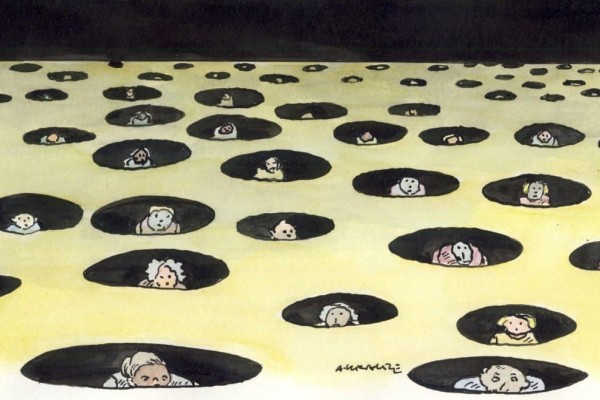The birth of Medicare
From Saskatchewan’s breakthrough to Canada‑wide coverage

Thousands of anti-government protestors rallied against Medicare in Regina, Saskatchewan, on July 11, 1962, in Canada. Photo from the Bettmann Archive.
Medicare was born in Saskatchewan on July 1, 1962. It would be the first government-controlled, universal, comprehensive single-payer medical insurance plan in North America. It was a difficult birth. The North American medical establishment and the entire insurance industry were determined to stop Medicare in its tracks. They feared it would become popular and spread, and they were right. Within 10 years all of Canada was covered by a medical insurance system based on the Saskatchewan plan, and no serious politician would openly oppose it.
The same interests that tried to prevent Medicare and are continually trying to destroy it in Canada have mostly succeeded in stopping similar progress in the United States. After more than half a century of struggle, the American Medical Association (AMA) and the private insurance industry still control the US medical system despite minor steps forward like Medicaid for the very poor and Medicare for the elderly. The latest plan passed by Congress and endorsed by the private insurance industry amounts to public subsidies for the insurance industry.
Commentators have often wondered why the campaign for state medicine succeeded in Canada and failed in the United States. The battle for Medicare occurred in the 1960s when our political culture was moving to the left. Medicare’s first breakthrough
It is not surprising that the first breakthrough would be in Saskatchewan. The province, which was the home base of “agrarian socialism,” had been governed since 1944 by the Co-operative Commonwealth Federation (CCF) led by T.C. (Tommy) Douglas. The CCF had originally intended to socialize much of the economy but, like social democratic formations elsewhere, had retreated from this position and by the 1950s concentrated on building a welfare state within a mixed economy. Medical care had always been a centerpiece of its welfare state program and by 1959 considerable strides had been made. The initial innovation was universal hospital insurance which was introduced as early as 1947, and by 1958 had been adopted nationally as a federal-provincial jointly funded program. This is what made it financially possible for Douglas to announce in 1959 that the province would be launching a universal medical insurance plan.
Universal state medical insurance was virtually the only major issue in the Saskatchewan provincial election of 1960. The promise of state Medicare was so popular that the opposition parties dared not oppose it outright, but they were distrustful of what they claimed would be CCF-administered “socialized medicine.” The organized medical establishment was not nearly so reticent and mounted a ferocious propaganda campaign fronted by the local College of Physicians and Surgeons with the support of the Canadian Medical Association (CMA), the AMA, the local economic elite and most of the media in the province. The College wielded tremendous power and discipline because it was the only economic group representing doctors and was also the licensing body which determined who could practice medicine. Doctors who favoured Medicare were isolated and ostracized by the hierarchy of the profession.
The local medical hierarchy in 1960 took much of their advice from outsiders and adopted tactics which had proved successful in many similar campaigns in the United States. They amassed $100,000 for propaganda purposes, a tremendous sum in 1960 and far more than any party would spend in a Saskatchewan provincial election. Every household received printed propaganda and advertisements flooded the radio and newspapers. Public meetings were held throughout the province and were addressed by prominent doctors and supporters, often under the auspices of local Chambers of Commerce and Boards of Trade.
The crudeness of the propaganda appears to have been based on the assumption that the Saskatchewan electorate was as unsophisticated as their American counterparts. There were denunciations of socialism, communism, “socialized medicine” and the evils of “compulsion.” People would not be able to choose their own doctors; there might be compulsory abortion; state bureaucrats might commit people to mental hospitals. It was suggested that many doctors would leave the province and be replaced by inferior foreign practitioners. “They’ll have to fill up the profession with the garbage of Europe. Some of the European doctors who come out here are so bad we wonder if they have ever practiced medicine.” Norman Ward, Saskatchewan’s most prominent political scientist at the time, asserted that the medical hierarchy “betrayed an ignorance of democratic processes in general, and Saskatchewan politics in particular, that would have been excessive in a gaggle of high school freshmen.”
The effectiveness of the anti-Medicare campaign can be judged by the results of the June 8, 1960 election. The CCF won 42 percent of the vote in a four-way race and 37 of the 54 seats in the legislature. The government interpreted the results, as did most academics and other neutral observers and even much of the media outside the province, as a mandate to proceed with a universal medical plan.
A renewed assault on Medicare
It appeared momentarily that democracy would prevail and the medical hierarchy would accept the decision of the electorate. Such optimism proved to be a chimera as the medical hierarchy and their friends in the provincial business class and local media elite prepared for a bitter assault on the principles of responsible government. They were assisted in this campaign by the local Liberal Party and by an array of obscurantist reactionaries who were mobilized for the occasion.
The initial purpose of the anti-Medicare campaign was to force the CCF government to go back on their election promise and stay out of the medical insurance field altogether. When it became clear that the CCF would do no such thing, the fallback position was trying to force them to water down government involvement, limiting it to subsidizing existing medical insurance schemes controlled by organized private medicine.
Tommy Douglas himself could be considered the first political casualty. He had become the first leader of the newly founded NDP in the fall of 1961, and was replaced by Woodrow Lloyd as provincial leader and premier. Douglas was defeated in a Regina constituency in the federal election of June 1962. The defeat was attributed partly to the campaign against Medicare.
The doctors’ strike
This article cannot do justice to the infamous doctors’ strike of July 1–23, 1962. Entire books have been devoted to it. It was the most polarized Saskatchewan battle of the 20th century and it divided the population into warring camps which brought the province to the brink of a civil war. The campaign, which included most of the local media, was based on outrageous lies about the intent of Medicare, racial slurs, red-baiting, acts of violence and threats of blood in the streets. One of the most infamous statements was made by the right-wing priest Athol Murray to an anti-Medicare rally, broadcast by radio to thousands more: “This thing may break into violence and bloodshed any day now, and God help us if it doesn’t.” This was merely one of the incendiary speeches Murray had been making throughout the province, and the Catholic Church to its credit ordered him out of Saskatchewan for the duration.
The anti-Medicare campaign gave rise to a right-wing movement known as the Keep Our Doctors (KOD) Committee. The KOD movement had many similarities to today’s rabid Tea Party movement in the United States. It was composed of an active, ignorant and misinformed rank and file, led by manipulative leaders with a right-wing political agenda. Prominent doctors and businessmen and leading lights of the local Liberal Party appeared on platforms with these fanatics. The interests behind the KOD were bent not only on stopping “socialized medicine” but in ridding the province of “socialism.”
The Lloyd government held firm despite tremendous pressure, and stared down the North America medical-industrial complex for 23 anxious days. This was made possible by the dedication of CCF rank and file activists and a dedicated core of socialists, trade unionists, agrarian radicals, and of a small minority of courageous doctors who defied the ostracism of their colleagues. They built community clinics with the initial aim of employing doctors who defied the strike. Their long-range aim was to provide a consumer-controlled alternative to entrepreneurial fee-for-service medicine. It was the possibility that the community clinics might become really widespread and popular that really frightened the medical establishment. The same people who organized the community clinics also organized such groups as Citizens in Defense of Medicare and Citizens for a Free Press to counter the anti-Medicare propaganda.
Public opinion swung against the anti-Medicare lobby partly due to the work of the pro-Medicare committees with much help from the Saskatchewan Farmers’ Union and the trade union movement, and partly because of a popular backlash against the excesses of the KOD. The College of Physicians and Surgeons was forced to call off the strike after an arrangement with the government, known as the Saskatoon Agreement, was made on July 23, 1962. The agreement included some compromises and ambiguities which allowed the College to continue harassing community clinic doctors and to hinder the growth of alternatives to fee-for-service entrepreneurial medicine. However, the main point of the agreement was that medical insurance would remain government-controlled, compulsory, universal and reasonably comprehensive. An important beachhead with national significance had been established, and the plan immediately became popular.
Unfortunately for Woodrow Lloyd and his government, they did not reap the immediate political benefits. Ross Thatcher, Liberal leader, had used the Medicare crisis to consolidate the disparate right-wing forces of the province around his leadership. The Liberals narrowly defeated the NDP in the provincial election of 1964. But to do so they had to promise to continue the medical care plan as it was. Henceforth no serious Saskatchewan politician could openly attack the principle of government-controlled universal Medicare.
How Medicare went national
That Medicare would spread so rapidly from Saskatchewan to the national level has often puzzled observers. It can be explained mainly by two factors: a miscalculation by the CMA, and the configuration of national political forces in the 1960s. By 1960 the CMA could see that Medicare would soon become a national issue. It hoped to stop any move towards what it called “socialized medicine” by making the case for a continuation of the existing doctor-sponsored medical insurance plans, subsidized by the state if necessary but controlled by the medical establishment. Consequently it pressed the Diefenbaker government to appoint a Royal Commission to examine the whole issue of the medical system.
The CMA strategy backfired. Diefenbaker appointed fellow Conservative and old seat-mate from law school, Mr. Justice Emmett Hall, to chair the Royal Commission. The Commission was intended to examine all aspects of Canadian health care. However, the public hearings overlapped with the debate then raging in Saskatchewan that was becoming a major issue in the House of Commons and beyond. Dennis Gruending, in his superb biography of Emmett Hall, describes the excitement around the hearings, which played to packed houses around the country. Labour and farm organizations, consumer groups, community associations and many churches recommended a public plan similar to the one introduced in Saskatchewan in the midst of such controversy. The CMA, the private insurance industry and their business allies wanted the government to endorse the plans already operating under the auspices of organized medicine and the insurance companies. People could pay their own premiums, with the government subsidizing the premiums of the poor based on means tests.
Gruending points out that Hall examined the evidence objectively and came down on the side of public Medicare, and then convinced those who were skeptical to go along with it. The first volume of the commission report, issued in June 1964, came out in favour of a comprehensive health insurance program to be jointly financed by the federal and provincial governments. “Although he didn’t admit it in the report, Hall’s proposal was essentially the Saskatchewan model on a national scale,” Gruending wrote.
The reaction to the Hall Report could probably best be summed up with the expression “all hell broke loose.” The usual suspects mounted a rhetorical battle on a national scale, generally divided along class and ideological lines. Emmett Hall, by now elevated to the Supreme Court, threw himself into the debate in favour of public Medicare, an unprecedented move for a Supreme Court Justice and Chairman of a Royal Commission.
By 1964 the pro-Medicare forces in the country were riding the crest of public opinion during a period when the political culture was moving to the left. The political alignment of national parties saw six years of minority governments over three elections between 1962 and 1968, and this favoured those political forces attempting to move the country in a more progressive direction. The NDP was growing and this strengthened left Liberals who argued that their party must protect their left flank. This in turn encouraged the red Tories within the Progressive Conservatives, who argued that the party must move left to remain electorally competitive. All of this was occurring during a minority situation when an election might occur at any time and no party wanted to be caught on the wrong side of a popular issue like public Medicare.
It took fierce struggles within both the Liberal and Progressive Conservative parliamentary parties, but in the end the party whips forced the right-wing into submission. The National Medical Care Insurance Act was passed in the House of Commons on December 8, 1966, by an overwhelming vote of 177 to 2. The starting date was July 1, 1968, and the Act provided that the federal government would pay about half of Medicare costs in any province with insurance plans that met the criteria of being universal, publicly administered, portable and comprehensive. By 1971 all provinces had established plans which met the criteria.
Forty-five years later, the right to universal and equitable Medicare is now in perhaps the greatest danger it has faced since 1970. The political culture has lurched dangerously to the right and the Harper government has essentially declared that it has no intention of enforcing the Canada Health Act. The popular forces which made Medicare possible will have to be revitalized if we are to preserve the achievements which took decades of struggle to accomplish.
Lorne Brown is the Founder and Clinical Director of Acubalance Wellness Centre, the first Traditional Chinese Medicine clinic in British Columbia dedicated to reproductive health and fertility.
Doug Taylor is a Toronto historian who was a member of the faculty of Lakeshore Teachers’ College (York University).
This article appeared in the July/August 2012 issue of Canadian Dimension (The Limits of Medicine in a Sick Society).










